Heirloom turkeys are a traditional breed of turkey which is not associated with large-scale commercial agriculture. Or, simply put, they are a step back to how things used to taste. Therefore, strict standards apply to labeling turkeys as “heirloom.”
The American Poultry Association only recognizes eight varieties of true heirloom turkeys. Namely Bourbon Red, Narragansett, Beltsville Small, White Holland, Standard Bronze, Black, Royal Palm, and Blue Slate. However, the Jersey Giant and Midget White are considered true heirlooms by the ALBC.
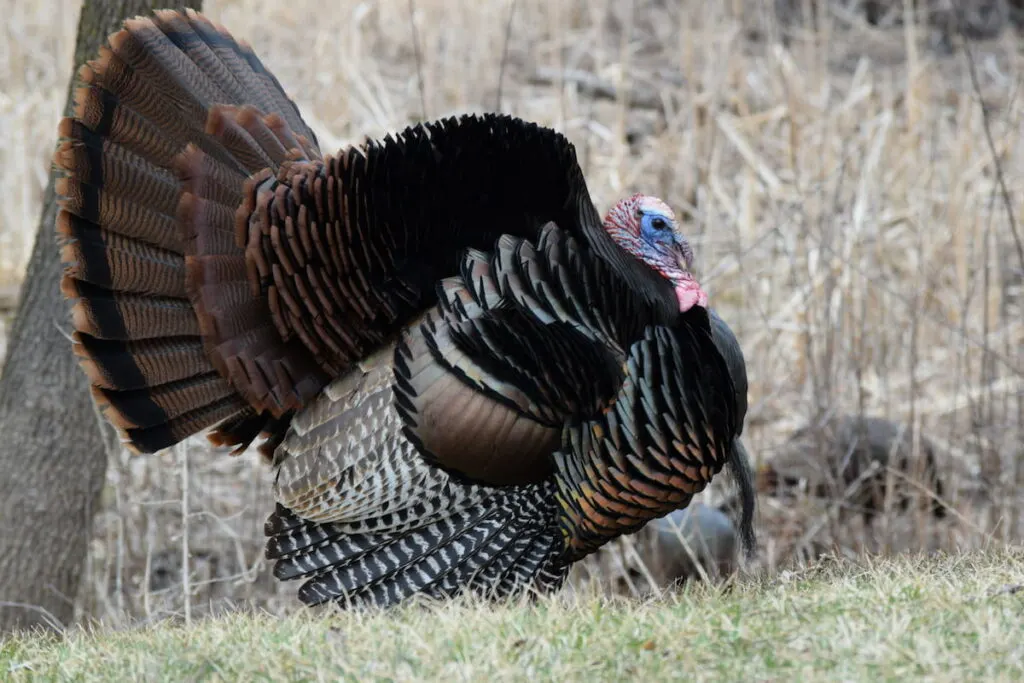
If you’re considering going the more natural route, by the way, which is becoming more common for most small farmers and homesteaders, then continue reading for the ten most popular recognized heirloom turkey breeds.
Table of Contents
What Are Heirloom Turkey Breeds?
Heirloom turkeys are purebreds that go back a long way. There are precise standards the breed has to meet.
Heirloom turkey breeds also refer to domestic turkeys that still retain their historic characteristics despite being bred over a long time.
Heirloom breeds must mate naturally, and they tend to have slower and smaller growth gains than their commercially bred counterparts, and they have to spend their lives outdoors. Because of this, they have less breast meat and more highly exercised, muscly thighs and wings with a stronger, somewhat gamy flavor.
Usually, 70 percent of the meat produced by a commercial turkey like the Broad-Breasted White turkey is breast meat, whereas heirloom breeds have about a 50:50 ratio of white meat to dark meat.
What makes the heritage turkeys stand out is that their characteristics are no longer present in the majority of commercial turkeys raised for consumption since the mid-20th century.
Heirloom breeds, however, became less popular through the years as modern agriculture took precedence. But the good news is that numbers are skyrocketing once again as people realize the importance of heritage breeds!
Heritage breeds offer such excellent benefits and traits regarding the future of growing stronger, self-sufficient food.
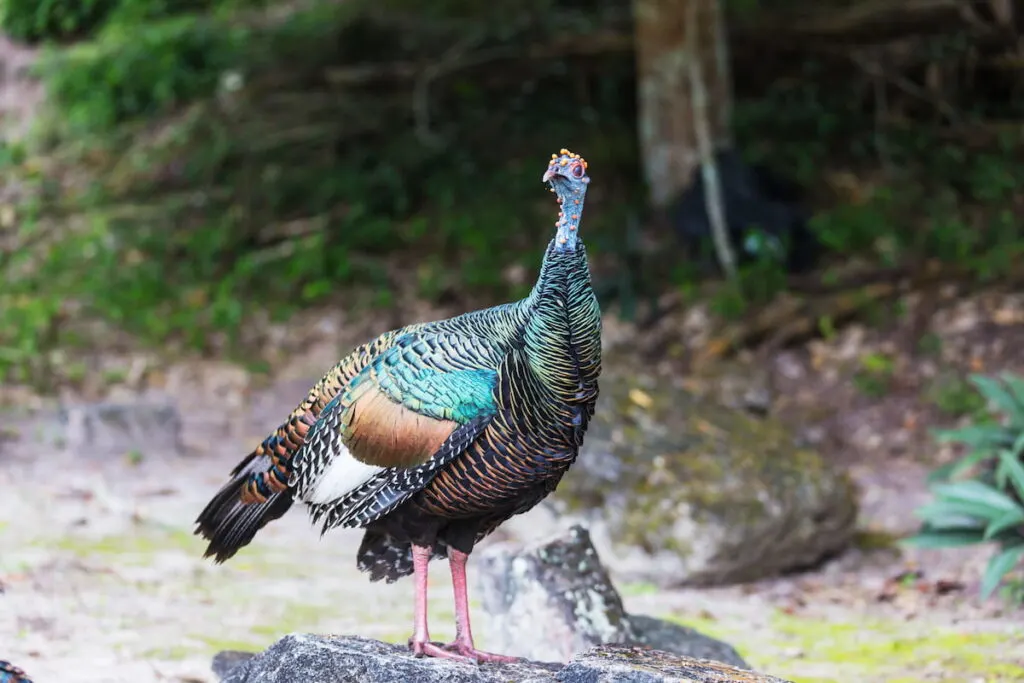
Here are the benefits that we need to pay special attention to:
- Disease resistant
Heirloom breeds are more disease-resistant than commercial turkey breeds. In addition, heirloom turkeys can thrive in various climates throughout the country and survive harsher environmental conditions than commercial turkeys.
- Parasite-resistant
Besides being disease-resistant, heirloom breeds are more parasite-resistant to most parasites affecting commercial turkeys.
- Better maternal instincts
Heirloom turkey breeds make excellent mothers due to their maternal instincts. They get broody and hatch their poults, and they also take good care of their poults.
However, maternal instincts and abilities vary in variety.
- Better fertility
Heirloom turkey breeds can mate naturally with no human intervention, with a 70 to 80 percent expected fertility rate. As a result, heirloom turkey hens lay healthy, fertile eggs.
In addition, most of their eggs have a high chance of hatching.
- Foraging abilities
Heirloom turkeys have extensive foraging abilities. So, they do not need as much feed as commercial turkeys.
They like to forage for a lot of their grub, cleaning up and controlling pests and insects around the farm or homestead.
- Longevity
Heirloom turkeys are capable of the full expected lifespan of wild turkeys. Breeding hens are usually productive for 5–7 years and breeding toms for 3–5 years.
Most of today’s commercial turkeys must be bred through artificial insemination as they are too big to reproduce naturally.
- Better ability to mate naturally
Heritage turkeys can mate naturally and will lay a few clutches of eggs per season.
According to The Livestock Conservancy, turkeys must result from natural reproduction to truly qualify as heirloom turkeys.
Heirloom Turkey Varieties
Many turkey varieties are classified as heirloom turkeys. However, in its Standard of Perfection, the American Poultry Association (APA) only recognizes eight varieties of turkeys that are considered true heirloom varieties.
Eight True Heirloom Varieties:
- Bourbon Red Turkey
- Narragansett Turkey
- Beltsville Small White Turkey
- White Holland Turkey
- Standard Bronze Turkey
- Black Turkey
- Royal Palm Turkey
- Blue Slate Turkey
Bourbon Red Turkey
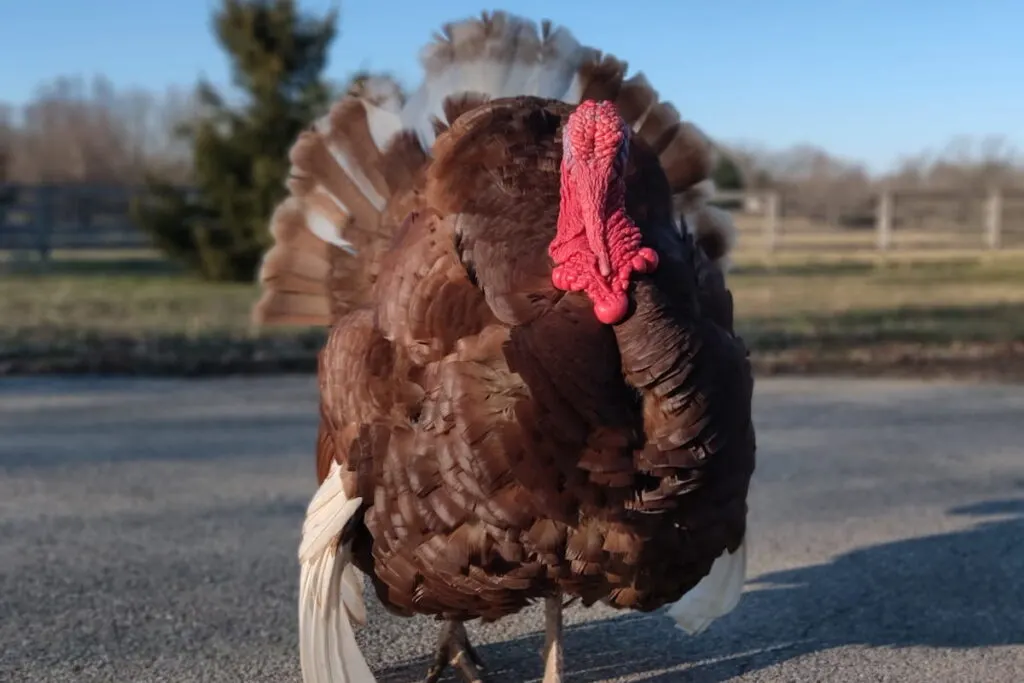
Bourbon Reds are one of the most famous heritage turkeys in the United States. They were developed in the 1800s in Bourbon County, Kentucky, through cross-breeding Buff, Standard Bronze, and White Holland Turkey heirloom turkeys.
The Bourbon Red breed standard indicates that mature Bourbon Red toms weigh up to 23 pounds, and mature hens weigh up to 14 pounds. Although, Bourbon Red heirloom breeders rarely recognize these weights as they tend to be smaller than the previously set standard.
Bourbon Red turkeys are handsome for exhibition or your backyard. They are noted for their beautiful brownish to dark red plumage and white flight and tail feathers. In addition, their tail feathers have soft red bars near the ends.
Their body feathers may be edged in black, and their neck and breast feathers are chestnut to mahogany color, with light buff under color feathers. In addition, they have red throat wattles that are changeable to bluish-white, with black beards and pink shanks and toes.
The Bourbon Red is an active forager that does well in pasture production systems.
Bourbon Reds were selectively bred and promoted for their utility traits as a meat bird with a heavy breast and richly flavored meat.
Narragansett Turkey
Named after where they were developed, the Narragansett turkey is named after Narragansett Bay in Rhode Island. Narragansett turkeys were initially developed by cross-breeding eastern wild turkeys with domestic turkeys.
Improved and standardized for production qualities and flocks of up to 200 turkeys, the Narragansett turkey became the staple of the turkey industry in New England before factory-farmed turkeys became popular. The American Poultry Association recognized the Narragansett turkey as a true heirloom breed in 1874.
The standard weight for toms is 23 pounds and 14 pounds for young hens. The Narragansett, however, has not been selected for production attributes, including weight gain, so many may be smaller than the standard weight.
The Narragansett turkey is beautiful with striking color patterns of black, gray, tan, and white. The Narragansett has a horn-colored beak, a red to bluish white head, a black beard, and salmon-colored shanks and feet.
Narragansett turkeys are traditionally known for their calm disposition, good egg production and maternal instincts, early maturation, and excellent meat quality.
Beltsville Small White Turkey
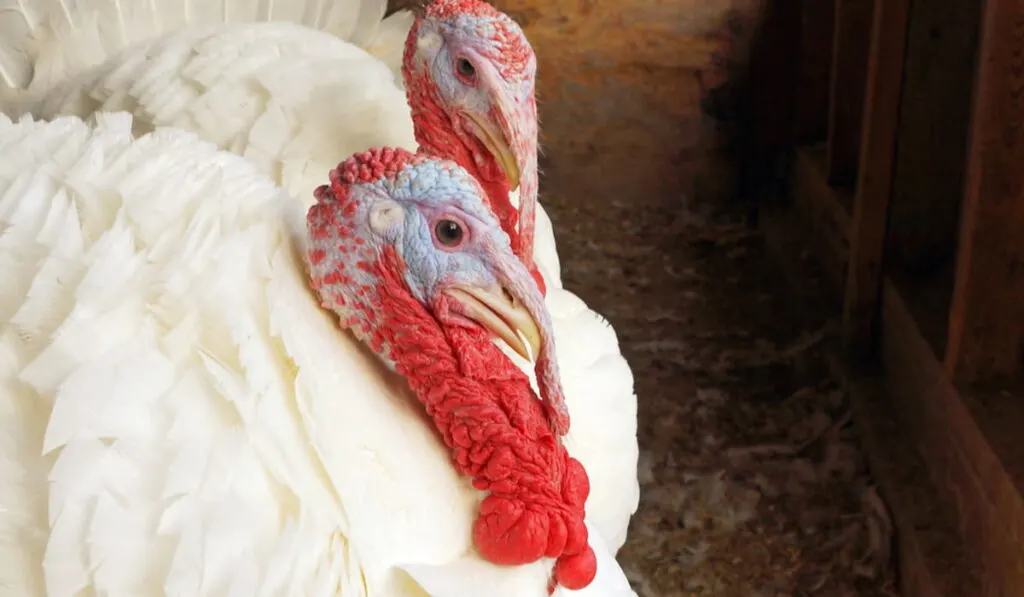
The Beltsville Small White turkey was explicitly developed to fill an identified consumer need.
Home consumers wanted a meaty, well-finished, New York-dressed bird weighing between 8 and 15 pounds. So, researchers in Beltsville, Maryland, developed the new Beltsville Small White turkey variety from using genetics, including the White Holland, White Austrian, Narragansett, Bronze, and Wild Turkey.
The Beltsville variety was introduced in the 1940s and was recognized by the American Poultry Association in 1951.
Young Beltsville toms weigh 17 pounds, and young hens weigh 10 pounds.
Beltsville’s have white plumage with a red to bluish-white head. They have a black beard, a horn-colored beak, and pinkish-white shanks and toes.
The Beltsville Small White turkey’s success was short-lived, and by the 1970’s they were nearly extinct. Today, the Beltsville Small White is still relatively rare; however, in recent years, there has been a revival of interest in this variety due to their excellent reproductive qualities, including their ability to mate naturally and their prolific laying tendencies.
White Holland Turkey
The White Holland turkey was recognized as the most important white-feathered turkey variety throughout most of American history. Initially bred in Holland, White Hollands migrated with early settlers to the United States in the 1800s.
The American Poultry Association recognized White Holland turkeys in 1874.
White Holland toms weigh up to 25 pounds, and young hens weigh up to 16 pounds.
The White Holland turkey is a showy bird with snow-white feathers and a red to bluish head. They have black beards, pink to horn-colored beaks, and pinkish-white throats and wattles. Their shanks and toes are pinkish-white, and their eyes must be brown to qualify as heirlooms.
White Holland turkeys are calm, good setters, and excellent mothers; however, the hens often break eggs due to their hefty build.
Despite their illustrious past, the White Holland turkey is one of the rarest and most difficult to authenticate varieties today.
Standard Bronze Turkey
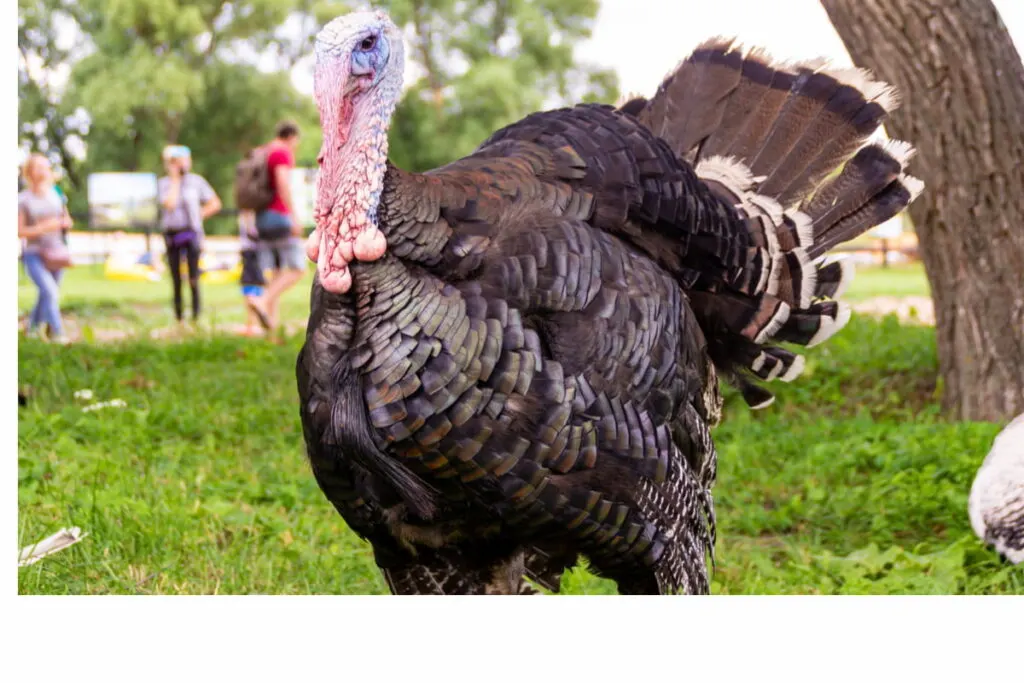
As one of the largest turkey breeds, the Standard Bronze turkeys are the most popular turkey breed for most of American history. The Bronze turkey originated from cross-breeds between the eastern wild turkey and domestic turkeys brought by European colonists to the Americas.
Bronze turkeys were known by the late 1700s but only received their name “Bronze” in the 1830s. The American Poultry Association recognized the Bronze variety in 1874.
This cross’s hybrid vigor resulted in larger turkey stocks, with a standard weight of toms weighing 25 pounds and young hens weighing 16 pounds.
They have an inherited coppery-bronze-colored metallic sheen from their wild ancestors, giving the variety its name.
Naturally mating, long-lived, slow-growing strains of Standard Bronze turkeys have been left even far behind by the turkey industry and are replaced with the Broad-Breasted Bronze variety.
The ALBC lists the Standard Bronze as “critical” on their conservation priority listing.
Black Turkey
Also commonly known as the Black Spanish or Norfolk Black, the Black turkey originated in Europe as a direct descendant of the turkeys from Mexico carried home with explorers in the 1500s. The American Poultry Association recognized the Black in 1874.
According to the breeding standard, the standard weight for a Black turkey is 23 pounds for toms and 14 pounds for young hens. However, Black turkeys have not been selected for production attributes for years, and many birds may be smaller than the breeding standard.
Black turkeys have a lustrous, metallic black plumage with a greenish sheen and a dull black under color. They have black beaks, red wattles that are changeable to bluish-white and pink shanks and toes.
The Black turkey is a threatened breed, but fortunately, a renewed interest has spiked due to their natural breeding abilities, biological fitness, survivability, and superior flavor.
Royal Palm Turkeys

Royal Palm turkeys were first showcased in the 1920s on a farm in Lake Worth, Florida. The first turkeys in America to have the “Palm color pattern” appeared in a mixed flock of Standard Bronze, Black, Narragansett, and wild turkeys on Enoch Carson’s farm in Lake Worth.
Further selections were made to stabilize color consistency and other characteristics. As a result, the American Poultry Association recognized the Royal Palm in 1971.
Standard weights for Royal Palm turkeys are 16 pounds for toms and 10 pounds for young hens. The Royal Palm turkey is primarily bred as an exhibition variety and has not purposefully been selected for growth rate or muscling.
The Royal Palm is a striking, small-sized turkey variety with contrasting white, metallic black edges on its feathers. They have snow-white tails, wings, and breasts, with a contrasting band of black and white edges.
They also have red to bluish whiteheads, light horn beaks, black beards, red to bluish white throats and wattles, deep pink shanks and toes, and light brown eyes.
Royal Palms are active, thrifty turkeys, excellent foragers, and good flyers.
Royal Palms are raised for ornamental and display purposes more often than not and lack the commercial potential of the other heirloom turkey breeds. Still, they are suitable for small farms or home production of meat. In addition, they are active foragers with the ability to control insects and pests.
Despite Royal Palms being as attractive as they are, the American Livestock Breeds Conservancy considers this breed extremely rare.
Blue Slate Turkey
The Blue Slate turkey gene is a legitimate mutation that arose, producing this heirloom breed with a blue slate color in slightly different shades of grey. In addition, white and rusty brown markings may occur; however, these markings are considered a defect. The American Poultry Association accepted the Blue Slate in 1874.
The Standard weight for a tom is 23 pounds and 14 pounds for a young hen. However, the Blue Slate has not been selected for many years for production and weight gain attributes, meaning they may be smaller than the standard weight.
The Blue Slate turkey is named for its beautiful slate-grey plumage and solid to ashy blue color over its entire body, with or without a few black specks- hens are generally lighter than toms.
The Blue Slate has a red to bluish white head, throat, and wattle. In addition, it has a black beard, horn-colored beak, pink shanks and toes, and brown eyes.
According to the ALBC, Blue Slate turkeys are listed as “critically endangered.”
Additional Heirloom Varieties
In addition, the American Livestock Breeds Conservancy (ALBC) recognizes several additional varieties as heirloom turkeys.
Namely:
- Jersey Giant Turkey
- Midget White Turkey
Jersey Giant Turkey
The Jersey Giant derived from the mid-Atlantic region and are known for their abundance of white pinfeathers. The Jersey Giant was listed as a heritage breed by the American Poultry Association in 1874.
They are a small-to-medium-sized breed whose toms weigh 21 pounds, and young hens weigh 12 pounds.
These turkeys have rich, reddish-buff-colored body feathers, with white tail feathers and a buff bar near the end.
Midget White Turkey
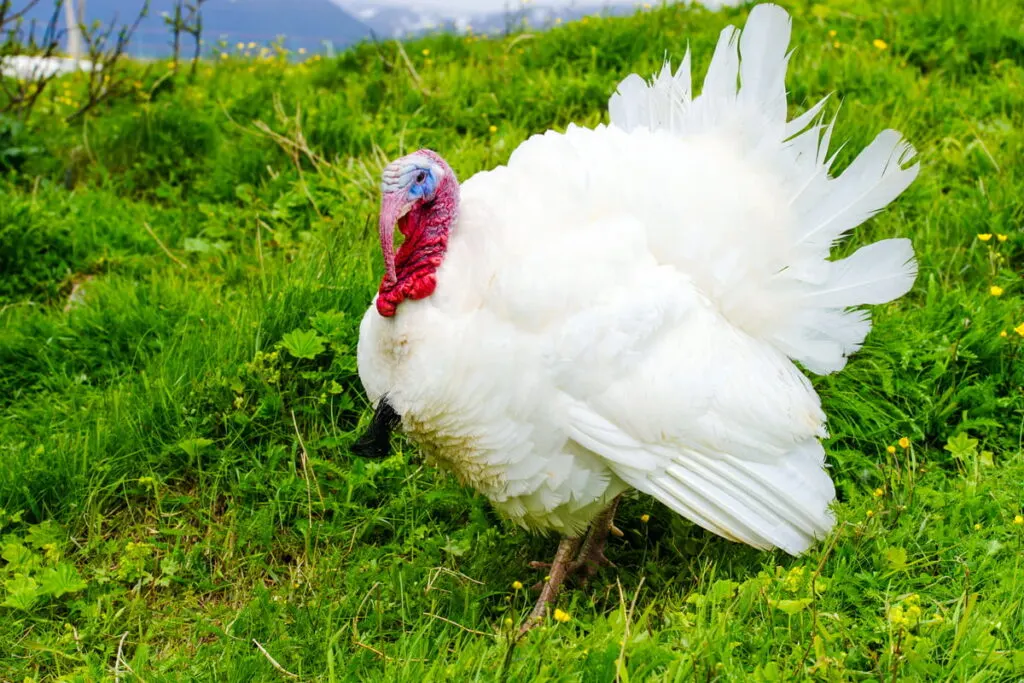
The Midget White turkey is a relatively new heritage breed developed in the 1960s by researchers at the University of Massachusetts. They are a cross-breed of Royal Palm and Broad-Breasted Whites. Toms weigh 13 pounds, and hens weigh 8 pounds.
Although a small breed, Midget Whites are wildly known for their deep, delicious flavor.
Conclusion
To conclude, heirloom turkeys are purebreds with particular breeding standards. Each heirloom turkey has its strengths and weaknesses; some of them are perfect for large thanksgiving dinners and others small enough for homesteading and instead considered eye candy.
If you’re looking for a turkey addition to your small farm or even a healthy dinner, heirlooms are definitely the way to go!
Resources
- https://alifeofheritage.com/farm-living/turkey-breeds/
- https://www.treehugger.com/choose-turkey-breeds-3016788
- http://petslady.com/article/feathered-forefathers-top-ten-heritage-turkey-breeds
- https://backyardpoultry.iamcountryside.com/poultry-101/six-heritage-turkey-breeds-on-the-farm/
